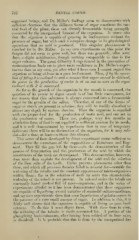Page 752 - My FlipBook
P. 752
762 DENTAL CARIES.
organized beings, and Dr. Miller's findings seem to demonstrate with
sufficient clearness that the different forms of sugar constitute the nat-
ural food of the plant, those not directly fermentable being promptly
converted by the unorganized ferment of the organism. It seems also
that the organism is capable of growing in beef-extracts without the
presence of sugar, but with such a complete change in its physiological
operations that no acid is produced. This singular phenomenon is
vouched for by Dr. Miller. In my own experiments on this point the
fungus did not seem to grow well, but there was generally, after some
days, a slight acidification, though nothing comparable to that in the
sugar cultures. The great difficulty I experienced in the prevention of
contaminations leads me to place more confidence in Dr. Miller's exper-
iments than in my own, yet after what I have seen I cannot regard the
organism as being at home in a pure beef-extract. Then, if by the opera-
tion offilling it is enclosed in such a manner that sugar cannot be obtained,
its power in the production of caries is at an end as soon as the sugar
enclosed with it is consumed.
So far as the growth of the organism in the mouth is concerned, the
question of its power to digest starch is of but little consequence, for
the reason that this substance is always converted into a fermentable
sugar by the j)tyalin of the saliva. Therefore, if any of the forms of
sugar or starch are present in solution, they will be readily absorbed to
almost any depth by carious dentine. Thus the organism is supplied
with the proper food for the production of lactic acid, and can act in
the production of caries. There are, perhaps, very few mouths in
which this form of food is not supplied in sufficient amount for its needs,
and it is well demonstrated by experiment that in case of temporary
deficiency there will be no destruction of the organism, for it may sub-
sist—for a time, at least—without this aliment.
This series of facts developed by direct experiment seems sufficient to
demonstrate the correctness of the suppositions of Robertson and Reg-
nard. They fill the gap left by them—viz. the demonstration of the
process of fermentation and the production of the acid by which the
constituents of the teeth are decomposed. This demonstration, however,
does more than explain the development of the acid and the solution
of the lime salts of the tooth. Caries ]>resents phenomena other than
these, and which all previous theories failed to account for—notably the
widening of the tubules and the constant appearance of micro-organisms
within them ; for in the solution of teeth by acids this characteristic
widening of the tubuli is not present. In natural caries the tubuli are
constantly found packed full of micro-organisms, and in the series of
experiments alluded to it has been demonstrated that these organisms
are capable of liquefying several varieties of semisolid culture-mediums,
and my own experiments show that some liquefaction of gelatin occurs in
the j)resence of a very small amount of sugar. In addition to this, it is
fairly well shown that the organism is capable of living on pure beef-
extracts. To do this it must digest them. With these facts in view,
the widening of the tubules is easily accounted for. A portion of the
glue-giving basis-substance, after having been robbed of its lime salts,
is dissolved. It is probable that this is done by the unorganized fer-


